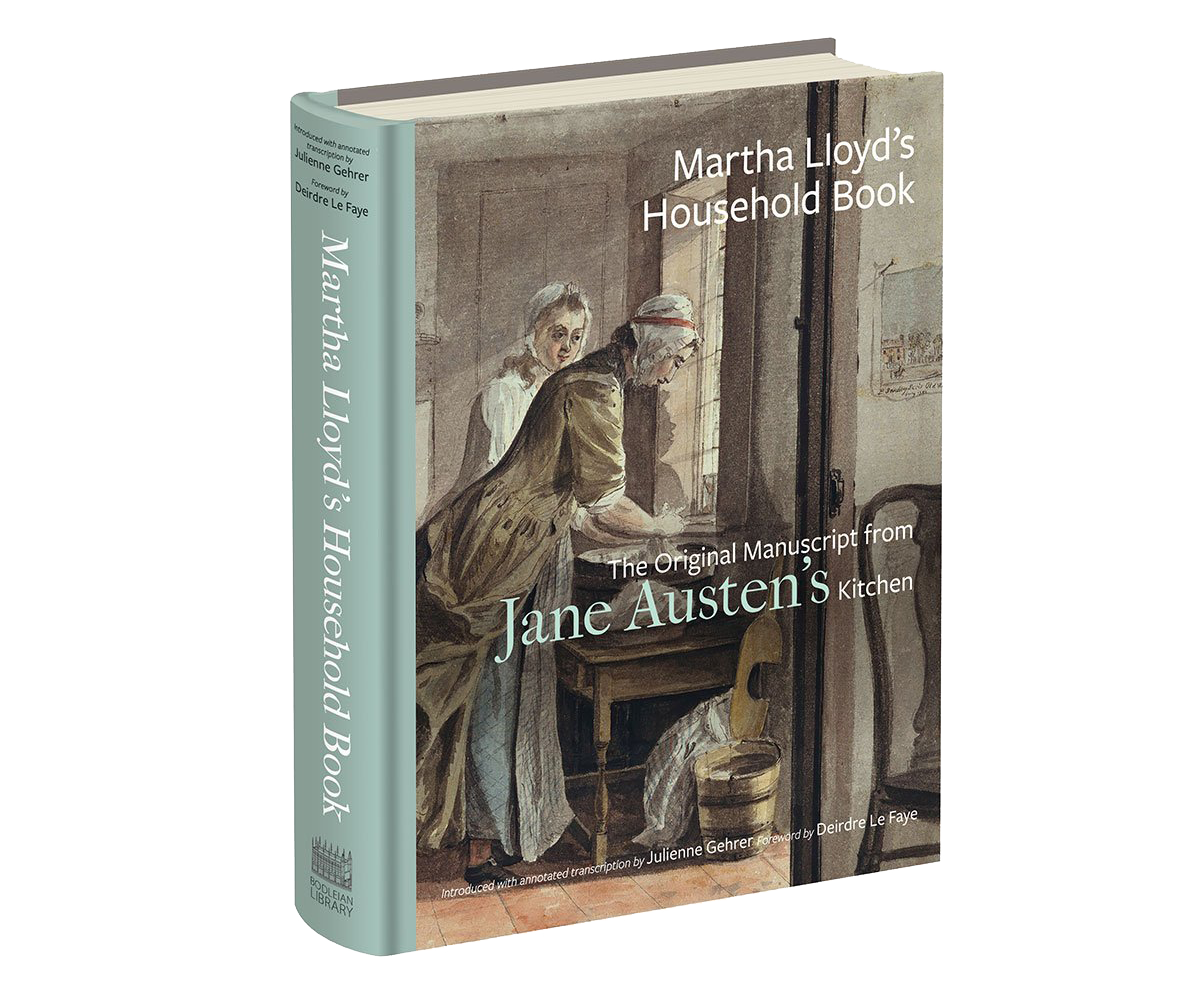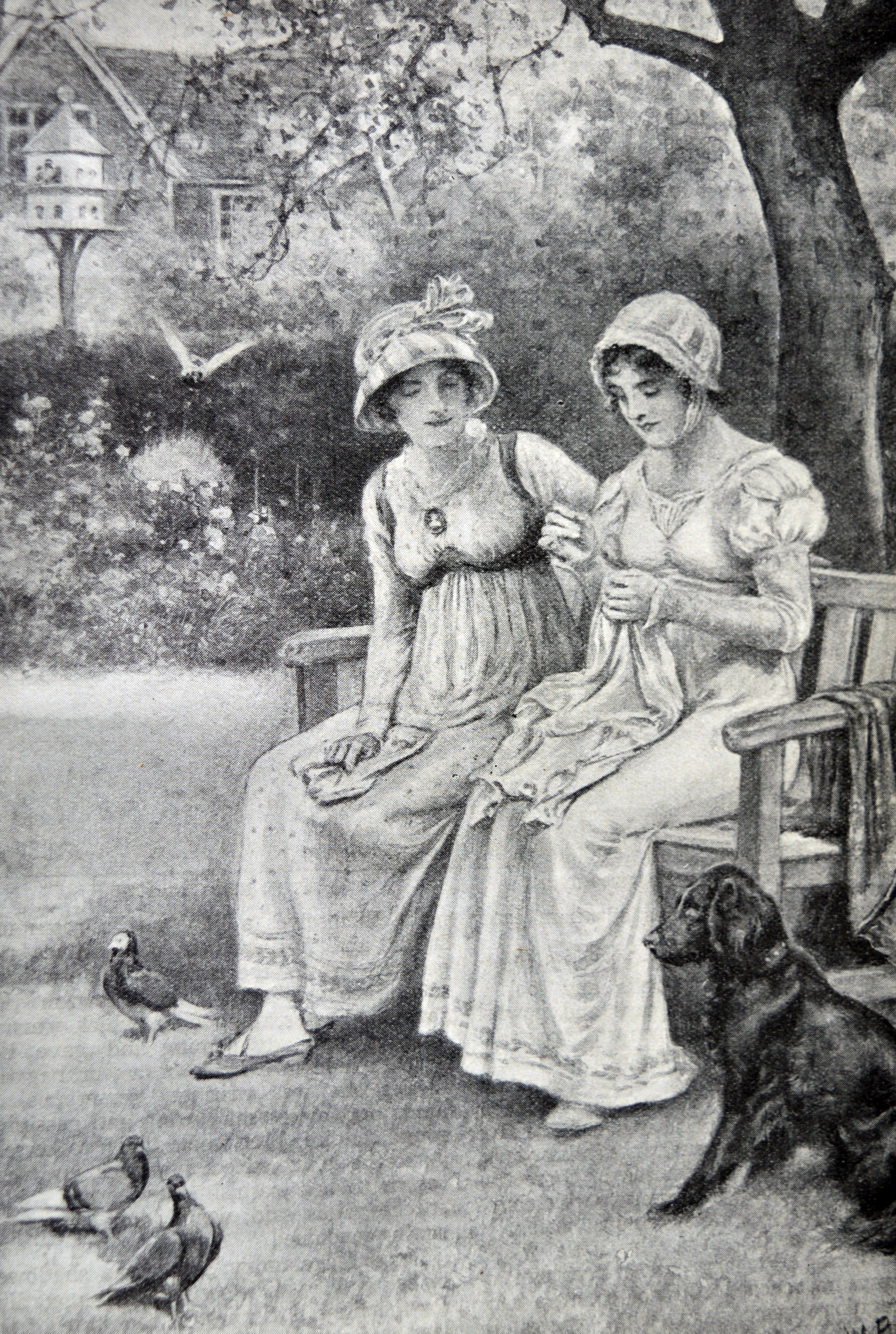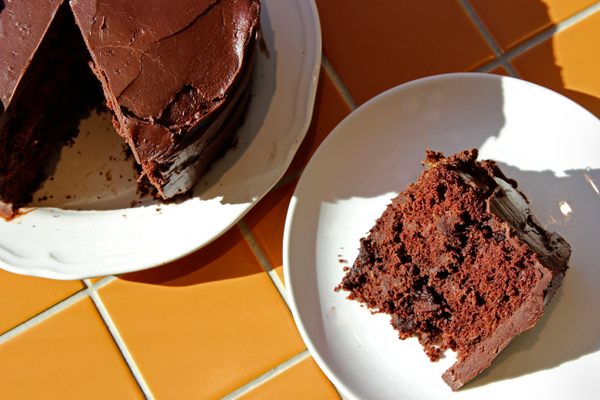Eat Like Jane Austen With Recipes From Her Sister-In-Law’s Cookbook
Including dishes straight from her novels.
A kind-hearted spinster, passed over in her youth by a potential suitor, spends her life faithfully tending the hearth and home of her dear family and friends. She is content to toil as a housekeeper, unrecognized but for the praise of beloved companions. All the while, she keeps a detailed household book of handwritten recipes, from carraway cake to currant wine, that her family loves. Virtue is rewarded when, at 63 years of age, the loyal spinster weds the widower brother of her dearest friend, who is subsequently knighted, making her Lady of a great house. Nearly 200 years later, an academic press publishes her book of household recipes, thereby inscribing the humble homemaker into the echelons of literary fame.
This isn’t a plot from a Jane Austen novel—it’s part of the history of the Austen family. Born to a vicar in Wiltshire, Martha Lloyd was 10 years older than Jane Austen, but became fast friends with teenage Jane and her sister Cassandra, and later relatives through marriage. “It was a matter of months until Jane was dedicating one of her juvenile works to Martha,” says Julienne Gehrer, a former editorial director at Hallmark cards who is now an independent Austen scholar.
In 1806, following the death of both Mr. Austen and Mr. Lloyd, Jane, Martha Lloyd, Jane’s sister Cassandra, and Jane’s mother formed a household together. Jane and Martha had already either refused or been heartbroken by multiple suitors, so they formed a household with sisterhood at the core. They eventually settled at Chawton Cottage in Hampshire, a medium-sized cottage on the grounds of brother Edward Austen’s large manor. Now home to the Jane Austen museum, Chawton Cottage is where Jane either wrote or revised all six of her published novels. It’s also where, for decades, Jane’s beloved friend and relative Martha Lloyd created her household book, a record of the family’s favorite recipes gleaned from published cookbooks and friends.

Now, thanks to a collaboration between Gehrer, Jane Austen’s House, and the University of Oxford’s Bodleian Library, Austen lovers can read and cook from the same recipes Jane once enjoyed. As of late June in the UK, and August in the United States, readers will be able to purchase a full reproduction of Martha Lloyd’s Household Book, which is on display in the Austen museum at Chawton. The new edition contains a full facsimile original manuscript, with a deep-brown sheep parchment cover and yellowing pages covered in Martha Lloyd’s loopy handwriting, as well as Gehrer’s painstaking transcription of the entire contents. (Gehrer previously used the manuscript to compile a self-published collection of Austen-inspired recipes, Dining with Jane Austen, in 2017.)
Written in narrative form with little by way of precise directions, the recipes—for cowslip wine and cabbage pudding; pickled mushrooms and cowheel soup—are artifacts of the Georgian-era English countryside. For the Austen aficionado or adventurous cook, they’re also a vibrant glimpse into the daily life of an author whose own gaze of domesticity was so unshakingly vivid.
Martha Lloyd’s Household Book is part of a centuries-old tradition of British housekeeping, which originated in the early modern period. Hand-copying recipes into household books was typically a pastime of the educated and landed classes, since women were often literate and could afford still-expensive luxuries like paper. Extremely wealthy women might own a few printed cookbooks; others would write down recipes transmitted orally, or from books borrowed from circulating libraries. Household books demonstrate women’s close relationships with each other. “You can envision these women visiting family members and taking their household books,” says Gehrer. Typically, these women would use the books to direct the household’s hired cook, rather than cook themselves.

There was little difference between medicinal and culinary recipes—food was regarded as key to regulating health, and medicine as a kitchen-table art—and household books might list pickle recipes next to instructions for treating mange in horses or curing plague.
The Austen and Lloyd women ate well. They kept a large vegetable garden, chickens, and, sometimes, bees, and had ample access to meat and poultry from local farms and hunting grounds. They would have employed a cook and bailiff to do heavier farm work.
Martha Lloyd’s recipes reflect this rural abundance. Lloyd’s recipe for “Swiss Soup Meagre,” for example, calls for cabbage, endive, sorrel, “Spinnage,” cherville, chives, onions, parsley, beet leaves, cucumbers, peas, and asparagus. Dairy-rich recipes include “snow cheese,” a sweet cheese of cream and lemon juice. The mid-afternoon daily dinner usually including a few different dishes; one dinner Austen mentioned in a letter consisted of “pease-soup, a sparerib, and a pudding.”
Martha Lloyd’s Household Book also includes influences from much farther afield. The British Empire’s violent colonial expansion in Africa, Asia, and the Caribbean—including the horrors of the transatlantic slave trade—made sugar an increasingly accessible ingredient, as evidenced in the book’s plethora of puddings. Flavors seized from South Asia dot the volume, including “a Receipt to Curry [chicken] after the India Manner” and “India Pickel,” a recipe for cabbage or cauliflower preserved in vinegar, mustard seed, and “Termeric.” Martha’s book also reflects the British elite’s craze for French cooking, including recipes such as fricassee turnips and a “harrico of mutton.” The taste for French food was a point of class snobbery: In Pride and Prejudice, the cultured Mr. Hurst snubs Elizabeth Bennet for preferring plain English fare to French ragout.

The Austen family dots the book—as do brief but tantalizing allusions to Martha’s intimate life. The book includes a playful verse recipe from Mrs. Austen, Jane and Cassandra’s mother, with a possible allusion to Martha’s crush on a local vicar: “If the vicar you treat, you must give him to eat, a pudding to hit his affection,” the recipe begins. Food also foreshadows Martha’s eventual marriage to Captain Francis Austen, Jane’s brother, in the form of a recipe for Captain Austen’s garlicky fish sauce.
Jane’s letters tell us that she, too, took an interest in household management. While Martha, Cassandra, and Mrs. Austen were the true household managers, says Gehrer, “It’s astounding what the woman knew about the kitchen, although she certainly chose to be behind the pen as opposed to the paring knife.” She kept the keys to the family’s sugar, tea, and wine stores, and she prepared the family’s simple breakfast. She also occasionally took over as housekeeper when the others were away or unwell. “I always take care to provide such things as please my own appetite, which I consider as the chief merit in housekeeping,” Jane wrote in a letter to Cassandra. “I have had some ragout veal, and I mean to have some haricot mutton tomorrow.” But housekeeping ultimately interfered with her writing. “Composition seems to me impossible, with a head full of Joints of Mutton & doses of rhubarb,” she wrote in 1816.
Some of the dishes Jane mentions in her literary work seem to come straight from Martha’s book. Jane often used food to illustrate the class and gender foibles of her characters. “She typifies good housekeeping in her good characters and poor housekeeping in the characters she looked down on,” says Gehrer. In a juvenile work, Leslie Castle, Austen describes a character running “with her face as White as a Whipt syllabub,” referencing a boozy whipped cream. Martha Lloyd’s Household Book features syllabub as the perfect topping for trifle (recipe below). In Pride and Prejudice, Mr. Bingley promises to send out invitations for his ball “as soon as Nicholls [the cook] has made white soup enough.” White soup was common ball fare, and Martha Lloyd’s recipe for it includes a mixture of cream, broth, finely ground almonds, and crushed egg yolks.

Of course, we can’t be sure that Martha Lloyd’s are the precise recipes Austen had in mind. “I wish there were margin notes that said, ‘This is the white soup from Pride and Prejudice.’ We don’t know that,” says Gehrer. But “it’s too irresistible not to draw a line between those two things.”
As revealing as the household book is, it remained obscure for almost two centuries. After Martha, by that time Lady Austen, died, the book was passed down in the Lloyd-Austen family. In September 1953, Rosa Mary Mowll, the great-granddaughter of Sir Francis Austen by his first wife, wrote a letter to the Jane Austen Memorial Trust asking if they were interested in a worn old book “which has Martha Lloyd’s name inside & is inscribed ‘Cookery interest’.’” But R. W. Chapman, a Trustee and editor of Austen’s work, dismissed the book, writing in a letter to another trustee that the book had “no actual Austen in it … it is of very little commercial value.” Chapman neglected the fact that the book contained recipes from the Austen family. More importantly, he overlooked this record of domesticity’s incredible insight into an author celebrated precisely because of her minute attention to the foibles of daily life.
Jane Austen’s House eventually acquired the Household Book, which Gehrer first spotted on a visit to Chawton Cottage. After years of “polite nagging,” says Gehrer, the House and the University of Oxford’s Bodleian Library agreed to publish it, with Gehrer as editor. Part of a trend of scholars paying increasingly serious attention to how women writers felt about food and domesticity, the book is a vibrant testament to the everyday labor that goes into creating literary genius. “Intellectual work is not separate from housework,” Gehrer says. And the book is a reminder of the life of Martha Lloyd, a woman whose industry, charity, and grace made her a character right out of a Jane Austen novel.

A Trifle With Whipt Syllabub
Martha Lloyd’s Recipe: A Trifle
Take three Naple Biscuits cut them in Slices dip them in sack lay them in the bottom of your dish then make a custard of a pint of cream & five Eggs & put over them then make a whipt Syllabub as light as possible to cover the whole the higher it is piled the handsomer it looks.
Published by Bodlein Library and Jane Austen’s House. Naple Biscuits were crisp sugar biscuits often used in puddings; sack is a word for sherry, which often came in a burlap sack.
Julienne Gehrer’s Adaptation: A Trifle With Whipt Syllabub
Copyright Julienne Gehrer. Originally published in Dining With Jane Austen, 2017. Trifle Adapted from Martha Lloyd’s Household Book. Syllabub adapted from The Art of Cookery Made Plain and Easy by Hannah Glasse. Serves 10 to 12.
For the trifle:
5 eggs
¾ cup sugar
2 cups cream
24 ladyfingers
½ cup sherry or light rum
For the syllabub:
2 cups cream
½ cup sugar
1 tablespoon sherry or light rum
Zest of one lemon
- In a large mixer bowl, whip eggs and sugar together until thick and lemon-colored.
- Warm cream in a large saucepan over medium heat. Remove from heat. In a very thin stream, slowly pour about half of the cream into the egg mixture while beating. Pour the warmed egg mixture into the cream and return the saucepan to the heat.
- Cook custard over medium heat until thickened. Cool and refrigerate several hours.
- For the syllabub, whip cream in a large mixer bowl until light. Add sugar and whip until fluffy. Stir in 1 tablespoon sherry or rum and lemon zest.
- To assemble trifle, lay half of the ladyfingers in the bottom of a 2-quart dish and sprinkle with ¼ cup of rum. Top with half of the custard and slightly less than half the syllabub. Repeat with remaining ladyfingers, sherry or rum, custard, and syllabub. Refrigerate several hours before serving.
Gastro Note
Syllabub is a kind of alcoholic whipped cream that was popular in Georgian England. Historical recipes vary, but common elements include some kind of alcohol, lemon zest and juice, and cream. Historical versions of the boozy dessert range from frothy foam on top of bubbly white wine to a shaken curdled wine-and-cream, to a rummy whipped mouse.
Since Martha Lloyd didn’t include a recipe for the syllabub she added to the trifle in her household book—presumably because it was such a common recipe, she assumed any reader would know how to make it—Gehrer adapted a recipe from classic 18th-century British cookbook writer Hannah Glasse.
Feel free to play around with different alcohols for your syllabub. For my version, I used James Beard’s recipe and chose Riesling for the wine, which yielded a fizzy cloud of cream. I also dipped my lady fingers in limoncello rather than rum, for a sweet, citrusy, alcoholic twist on the trifle.

White Soup
Martha Lloyd’s Recipe: White Soup
Make your gravy of any kind of Meat, add to it the yolks of four Eggs boiled hard & pounded very fine, 2 oz of sweet Almond pounded, as much Cream as will make it of a good Color
Julienne Gehrer’s Adaptation
Copyright Julienne Gehrer. Originally published in Dining With Jane Austen, 2017. Recipe adapted from The Knight Family Cookbook. Serves 4 to 6.
8 cups veal or chicken stock
4 ounces vermicelli
4 hard-boiled egg yolks
¼ cup ground almonds
1 cup cream
- Bring veal or chicken stock to boil in a large pot over high heat. Break vermicelli into small pieces and add to stock. Boil pasta for 7 minutes or until tender. Remove soup from heat.
- Push egg yolks through a sieve using the back of a spoon. Do the same with the ground almonds, discarding any large pieces. Add yolks and almonds to soup.
- Slowly stir in cream, then return soup to heat. Cook over medium heat until just warm.
- Serve immediately.
Gastro Note
The Knight Family Cookbook, currently owned by Jane Austen’s House, is a household book initially compiled by the women of the Knight family, another family in Jane’s social circle. The only real difference between that recipe and Martha Lloyd’s is the addition of vermicelli.
Gastro Obscura covers the world’s most wondrous food and drink.
Sign up for our regular newsletter.




































Follow us on Twitter to get the latest on the world's hidden wonders.
Like us on Facebook to get the latest on the world's hidden wonders.
Follow us on Twitter Like us on Facebook